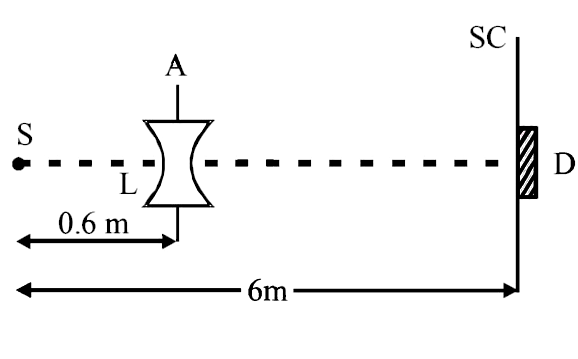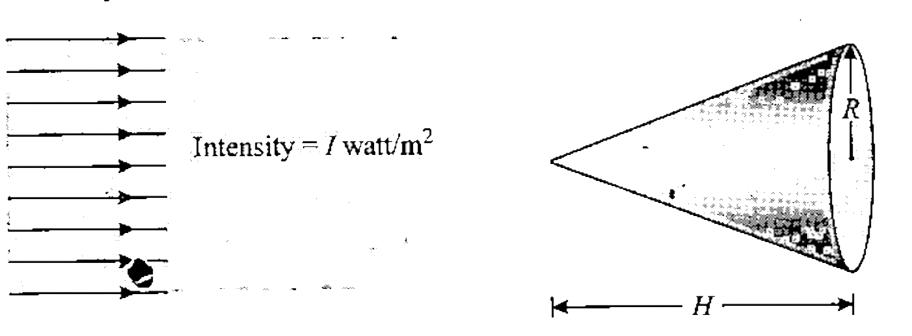Illustration from GK PUBLICATIONS PHYSICS Chapter 12 PHOTOELECTRIC EFFECT AND MATTER WAVES for Class 12
| Class 12 | PHYSICS |
| Chapter | PHOTOELECTRIC EFFECT AND MATTER WAVES |
| GK PUBLICATIONS PHYSICS | Illustration |
| Medium | English |
| Academic Year | 2023-2024 |
Question 1
The photoelectric threshold of the photo electric effect of a certain metal is 2750A∘. Find
(i) The work function of emission of an electron from this metal,
(ii) Maximum kinetic energy of these electrons.
(iii) The maximum velocity of the electrons ejected from the metal by light with a wavelength 1800A∘. View SolutionQuestion 3
In an experiment tungsten cathode which has a threshold 2300Å is irradiated by ultraviolet light of wavelength 1800Å. Calculate
(i) Maximum energy of emitted photoelectron and
(ii) Work function for tungsten.
(Mention both the results in electron-volts)
Given Planck's constant h=6.6×10−34joe–−sec, ≤V=1.6×10−19 joule and velocity of light c=3×108m/secView SolutionQuestion 4
Light of wavelength 180 nm ejects photoelectrons from a plate of metal whose work - function is 2 eV. If a uniform magnetic field of 5×10−5 T be applied parallel to the plate, what would be the radius of the path followed by electrons ejected normally from the plate with maximum energy.View SolutionQuestion 5
The rediation emitted when an electron jumps from n=3→n=2 orbit in a hydrogen atom falls on a metal to produce photoelectron. The electron from the metal surface with maximum kinetic energy are made to move perpendicular to a magnetic field of (1/320)T in a radius of 10−3m. Find (a) the kinetic energy of the electrons, (b) Work function of the metal , and (c) wavelength of radiation.View SolutionQuestion 6
Photoelectrons are emitted when 400nm radiation is incident on a surface of work - function 1.9 eV. These photoelectrons pass through a region containing α-particles. A maximum energy electron combines with an α -particle to from a He+ ion, emitting a single photon in this process. He+ ions thus formed are in their fourth excited state. Find the energies in eV of the photons lying in the 2 to 4 eV range, that are likely to be emitted during and after the combination. [Take,h=4.14×10−15eV−s] View SolutionQuestion 8
Electrons with maximum kinetic energy 3eV are ejected from a metla surface by ultraviolet radiation of wavelength 1500Å. Determine the work function of the metal, the threshold wavelength of metal and the stopping potential difference required to stoop the emission of electrons. View SolutionQuestion 11
When a surface is irradiated with light of wavelength 4950Å, a photocurrent appears which vanishes if a retarding potential appears which vanishes if a retarding potential greater than 1.2 volt is applied across the phototube. When a different source of light is used, it is found that the critical retarding potential is changed to 2.1 volt. Find the work function of the emitting surface and the wavelength of second source. If the photoelectrons (after emission from the surface) are subjected to a magnetic field of 10 tesla, what changes will be observed in the above two retarding potentials. Use h=6.6×10−34Js,e=1.6×10−19C.View SolutionQuestion 12
(a) If the wavelength of the light incident on a photoelectric cell be reduced from λ1 to λ2Å, then what will be the change in the cut-off potential?
(b) Light is incident on the cathode of a photocell and the stopping voltages are measured for light of two different wavelengths. From the data given below, determine the work function of the metal of the cathode in eV and the value of the universal constant hc/e.
WavelengthÅStopping voltage (volt)40001.345000.9View SolutionQuestion 13
Ultraviolet light of wavelength 2271Å from a 100W mercury source irradiates a photocell made of molybdenum metal. If the stopping potential is 1.3V, estimate the work function of the metal. How would the photocell respond to a high intensity (~105Wm−2) red light of wave length 6328Å produced by a He-Ne laser?View SolutionQuestion 14
The peak emission from a black body at a certain temprature occurs at a wavelength of 9000Å. On increase its temperature , the total radiation emmited is increased its 81 times. At the intial temperature when the peak radiation from the black body is incident on a metal surface , it does not cause any photoemission from the surface . After the increase of temperature, the peak from the black body caused photoemission. To bring these photoelectrons to rest , a potential equivalent to the excitation energy between n=2andn=3 bohr levels of hydrogen atoms is required. Find the work function of the metal.View SolutionQuestion 17
A cylindrical rod of some laser material 5×10−2m long and 10−2m in diameter contains 2×1025 ions per m3. If on excitation all the ions are in the upper energy level and de-excite simultaneously emitting photons in the same direction , calculate the maximum energy contained in a polse of radiation of wavlength 6.6×10−7m. If the pulse lasts for 10−7s, calculate the average power of the laser during the pulse.View SolutionQuestion 18
A 100 W sodium lamp is radiating light of wavelength 5890A, uniformly in all directions,
a. At what rate, photons are emitted from the lamp?
b. At what distance from the lamp, the average flux is 1 photon(cm2−s)−1?
c. What are the photon flux and photon density at 2m from the lamp?View SolutionQuestion 20
A uniform monochromatic beam of light of wavelength 365×10−9m and intensity 10−8Wm−2 falls on a surface having avsorption coefficient 0.8 and work functoin1.6 eV. Determine the rate of number of electrons emitted per m2, power absorbed per m2 and the maximum kinetic energy of emitted photoelectrons.View SolutionQuestion 21
When a beam of 10.6eV photons of intensity 2.0W/m2 falls on a platinum surface of area 1.0×104m2 and work function 5.6eV,0.53% of the incident photons eject photoelectrons. find the number of photoelectrons emitted per second and their minimum and maximum energies (in eV)Take 1eV=1.6×10−19JView SolutionQuestion 22
A beam of light has three wavelengths 4144Å, 4972Å and 6216Å with a total instensity of 3.6×10−3Wm−2 equally distributed amongst the three wavelengths. The beam falls normally on an area 1.0cm2 of a clean metallic surface of work function 2.3 eV. Assume that there is no loss of light by reflection and that each energetically capable photon ejects on electron. Calculate the number of photo electrons liberated in two seconds.View SolutionQuestion 23
A small plate of a metal (work function =1.7eV) is placed at a distance of 2m from a monochromatic light source of wavelength 4.8×10−7m and power 1.0watt. The light falls normally on the plate. Find the number of photons striking the metal plate per square meter per second. If a constant magnetic field of strength 10−4T is applied parallel to the metal surface, find the radius of the largest circular path followed by the emitted photoelectrons. (use h=6.63×10−34Js , mass of electron=9.1×10−31kg, charge of electron=1.6×10−19CView SolutionQuestion 24
A 40 W ultraviolet light source of wavelength 2480A. Illuminates a magnesium (mg) surface placed 2 m away. Determine the number of photons emitted from the surface per second and the number incident on unit area of Mg surface per second . The photoelectric work function for Mg is 3.68eV. Calculate the kinetic energy of the fastest electrons ejected from the surface. Determine the maximum wavelength for which the photoelectric effects can be observed with Mg surface.View SolutionQuestion 25
A mercury arc lamp provides 0.10 W of UV radiation at a wavelength of λ=2537Å(all other wavelenghts having been absorbed by filters). The cathode of photoelectric device (a photo-tube) consists of potassium and has an effective area of 4cm2. The anode is located at a distance of 1 m from radiation source. The work function for potassium is ϕ0=2.22eV.
(a) According to classical theory, the radiation from the arc spreads out uniformly in space as spherical wave. What time of exposure to the radiation should be required for a potassium atoms(radius 2 Å) in the anode to accumulate sufficient energy to eject a photo-electron?
(b) What is the energy of a single photon from the source?
(C) What is the flux of photons(number per second) at the cathode? To what saturation current does this flux correspond if the photo-conversion efficiency is 5% (i.e. if each photon has a probability of 0.05 of ejecting an electron).
(d) what is the cutt off potential V0?View SolutionQuestion 26
A monochromatic point source radiating wavelength 6000Å with power 2 watt, an aperture A of diameter 0.1m and a large screen SC are placed as shown in fig, A photoemissive detector D of surface area 0.5cm2 is placed at the centre of the screen . The efficiency of the detector for the photoelectron generation per incident photon is 0.9

(a) Calculate the photon flux at the centre of the screen and the photo current in the detector.
(b) If the concave lens L of focal length 0.6 m is inserted in the aperture as shown . find the new values of photon flux and photocurrent Assume a uniform average transmission of 80% from the lens .
(c ) If the work function of the photoemissive surface is 1eV . calculate the values of the stopping potential in the two cases (within and with the lens in the aperture). View SolutionQuestion 30
Hydrogen gas in the atomic state is excited to an energy level such that the electrostatic potential energy of H-atom becomes −1.7eV. Now, a photoelectric plate having work function w=2.3 eV is exposed to the emission spectra of this gas. Assuming all the transitions to be possible, find the minimum de-Broglie wavelength of the ejected photoelectrons.View SolutionQuestion 33
Assume that the de Broglie wave associated with an electron can from a standing wave between the atom arrange in a one dimensional array with nodes at each of the atomic sites. It is found that one such standing wave if the distance d between the atoms of the array is 2A0 A similar standing wave is again formed if d is increased to 2.5Å . Find the energy of the electrons in electron volts and the least value of d for which the standing wave type described above can from . View SolutionQuestion 34
In a photoelectric effect set up, a point source of light of power 3.2×10−3W emits monochromatic photons of energy 5eV.The source is located at a distance of a stationary metallic sphere of work function 3eV and radius 8×10−3m.The efficiency of photoelectron emission is one for every 106 incident photons.Assume that the sphere is isolated and initially neutral and the photoelectrons are initially swept away after emission.
Find the number of photons emitted per secondView Solution
